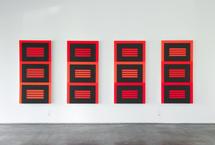López de la Serna CAC is proud to present its first exhibition project as a centre of contemporary art: The Early Paintings of the American artist Peter Halley (b. New York, 1953). This new phase will focus on programming curated exhibitions in our emblematic space in La Florida, in collaboration with both artists and institutions, both national and international. This inaugural show is made up of a careful selection of paintings from the second half of the 1980s, a foundational period in Halley’s career.
Halley’s work is characterized by chromatic intensity and uses of the language of geometric abstraction, in his case always with a figurative referent, as he has explained in his own writings on art. Although he acknowledges that he is heir to the abstract pictorial tradition, his return to geometry reflects the underlying structures of our technological society, thus contrasting with previous generations, who sought to represent the essential order of the universe — as in the visions of Malevich and Mondrian — or to evoke the sublime — in the case of American artists such as Rothko and Newman.
Halley recontextualizes the geometric abstraction of the avant-garde and preceding movements in an urban environment, providing a social and aesthetic critique of Modernism’s idealism. The work he produced in the early decades of his career has a solid theoretical foundation, outlined in a series of essays published in 1988 and considered an important contribution to postmodern critical discourse. In 1980, on his return to New York after studying for some years at prestigious academic institutions, he was struck by the functional role of geometry in that great metropolis. Intuitively he began to perceive the city as a geometric machine, a three-dimensional network where the uniformity and standardization of architecture allows for the systematized control of human beings.
It was then that the young Peter Halley became involved in the intellectual and artistic environment of the East Village, where he had his studio. This vibrant scene of galleries run by artists, in contact with critics and curators, gave rise to a new artistic current: Geometric Neo-Conceptualism. Halley was to be one of the leading exponents “Neo-Geo”, which emerged in response to Neo-Expressionist emotionality and Minimalist neutrality. For Halley, as for Albers, painting is about structure, space, internal tensions, and chromatic relationships, and colour was a primary compositional element. But if geometry used to be associated with progress and reason, now it has to do with established power and is an instrument of repression and domination of space.
Impressed by Frank Stella’s Morocco series (1964–65), Halley began to use fluorescent acrylic pigments in 1981. They give off an eerie glow that recalls the artificial lights of shopping malls and the mysterious luminescence of screens that broadcast seductive, brightly coloured advertisements; it creates an aura of attraction similar to that of stained glass, and the artist refers to Day-Glo paint as a signifier of low-budget mysticism. In that year he also experimented with a texture product that mimics the effect of stucco —marketed as Roll-a-Tex — and widely used on the rough-finished walls and ceilings of low-cost flats, motels, and other suburban interiors of the period.
Around the same time, the schematic image of a cell appears in his work as a symbol of alienation and isolation. These early paintings establish his characteristic iconography of prisons and cells linked by straight lines that he calls “conduits”. They reflect the organizational infrastructure of contemporary social space and the intense flux of people, commerce, and data in the post-industrial urban landscape of the digital age. They can be read as metaphors for the places where we live and work, as computer chips and communication channels. His large-scale canvases with pure colours combine the recurrent use of cell and circuit patterns with flat and relief elements, employing a reduced formal vocabulary that plays with variations of scale and combination or repetition.
Peter Halley’s work is to be found in numerous public collections, including those of MoMA and the Whitney Museum in New York, Tate Modern in London, the Stedelijk Museum in Amsterdam, the Museo Reina Sofía in Madrid, the CAPC Musée d’Art Contemporain in Bordeaux, and the Museum of Art in Seoul. Since the 1980s he has exhibited widely around the world. Recent exhibitions include Cell Gridsat Dallas Contemporary (2021), Heterotopia I at the Venice Biennale (2019), the Lever House Art Collection in New York (2018), Schirn Kunsthalle in Frankfurt (2016), Geometry of the Absurd at the Santa Barbara Museum of Art (2015), and Since 2000 at the Musée d’Art Moderne Saint-Étienne Métropole (2014). He is currently preparing a solo show at Mudam Luxembourg for next year.
